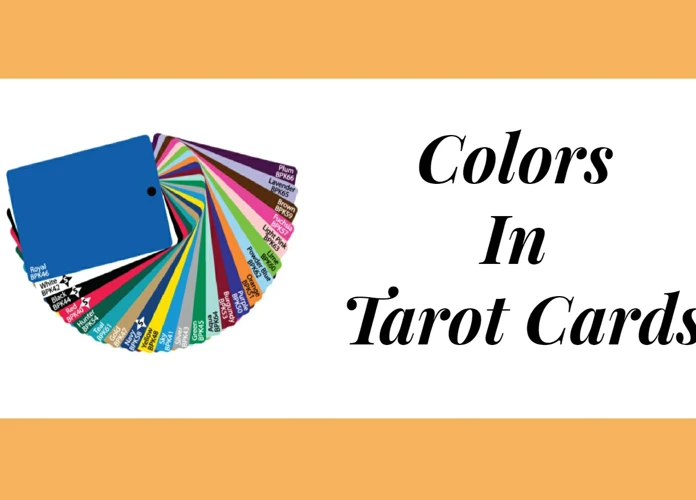Contents
- The Basics of Tarot Card Color Symbolism
- Understanding Elemental Associations
- The Role of Elemental Associations in Tarot Card Color Symbolism
- Fire Element and Color Symbolism
- Water Element and Color Symbolism
- Air Element and Color Symbolism
- Earth Element and Color Symbolism
- Conclusion
-
Frequently Asked Questions
- 1. Why is color symbolism important in tarot card readings?
- 2. How do elemental associations enhance tarot readings?
- 3. Can the same color have different meanings in different tarot decks?
- 4. What if a tarot card has multiple colors?
- 5. Are there specific color combinations that hold significance in tarot card readings?
- 6. How can I incorporate color symbolism into my own tarot readings?
- 7. Can the absence of color in a tarot card hold significance?
- 8. How can I deepen my understanding of color symbolism in tarot cards?
- 9. Are there cultural differences in interpreting color symbolism in tarot cards?
- 10. Can I use my intuition to interpret color symbolism in tarot cards?
- References
The Basics of Tarot Card Color Symbolism
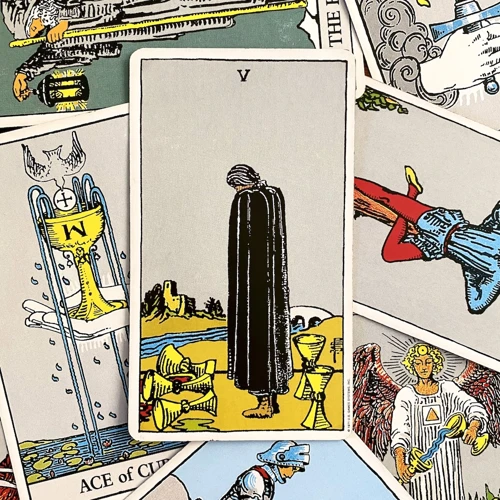
1. Red: Symbolizes passion, energy, strength, and bold action. It is often associated with the Fire element and represents vitality and ambition. Red-colored cards like the Emperor or the Knight of Wands may indicate assertiveness and the pursuit of goals.
2. Blue: Represents calmness, intuition, and spirituality. It is closely linked to the Water element and signifies emotions and psychic abilities. Blue-colored cards such as the High Priestess or the Ace of Cups may suggest introspection and the exploration of one’s inner world.
3. Yellow: Symbolizes intellect, optimism, and clarity. It is associated with the Air element and represents communication and mental processes. Yellow-colored cards like the Page of Swords or the Three of Swords may indicate intellectual growth and the need for clear thinking.
4. Green: Represents nature, growth, and healing. It is connected to the Earth element and signifies abundance and fertility. Green-colored cards such as the Empress or the Ten of Pentacles may suggest a focus on relationships, material well-being, and personal growth.
Understanding the basic color symbolism in tarot cards allows us to grasp the underlying energies and themes in a reading. It provides a foundation for deeper exploration and interpretation. By becoming familiar with the meanings associated with different colors, we can expand our tarot reading skills and gain a greater understanding of the messages that the cards are trying to convey.
Understanding Elemental Associations
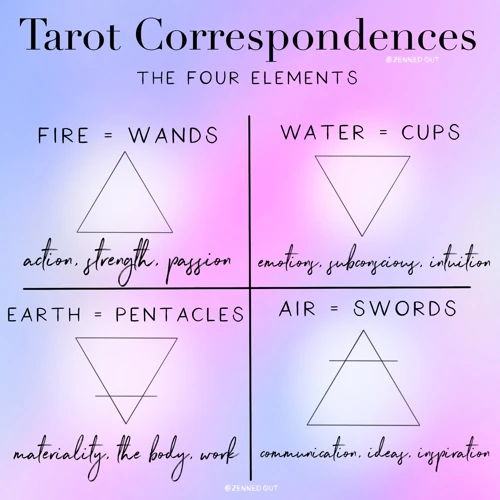
1. Fire: Represented by the color red, Fire is associated with passion, creativity, ambition, and transformation. It symbolizes action, movement, and the spark of inspiration. Fire is connected to the suit of Wands in the tarot deck, which often signifies intuition, energy, and the pursuit of goals.
2. Water: Linked to the color blue, Water is aligned with emotions, intuition, healing, and spirituality. It reflects the depths of the subconscious mind and represents the ebb and flow of life’s experiences. Water is associated with the suit of Cups, which symbolizes love, relationships, intuition, and emotions.
3. Air: Signified by the color yellow, Air is related to intellect, communication, clarity, and mental processes. It represents the power of thought, logic, reason, and inspiration. Air is aligned with the suit of Swords, which signifies intellectual growth, challenges, and the search for truth and understanding.
4. Earth: Portrayed by the color green, Earth embodies stability, grounding, abundance, and the physical realm. It represents practicality, material possessions, and our connection to nature. Earth is associated with the suit of Pentacles, which signifies wealth, health, security, and the tangible aspects of life.
By understanding the elemental associations in tarot, we can discern the overarching themes and energies present in a reading. These associations provide a deeper layer of meaning and allow us to connect more intimately with the cards. Whether we focus on the Fire element’s passion, the Water element’s emotions, the Air element’s intellect, or the Earth element’s stability, the elemental associations enhance our tarot readings and provide a richer understanding of the messages conveyed by the cards.
The Role of Elemental Associations in Tarot Card Color Symbolism
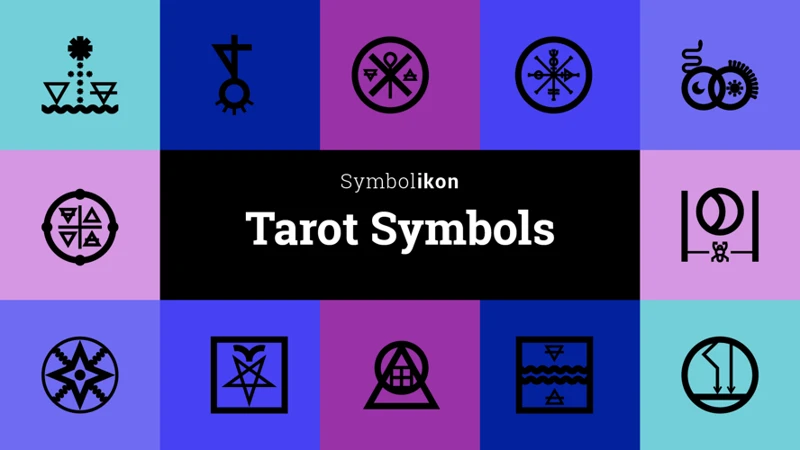
When we consider the elemental associations in tarot card color symbolism, we uncover a wealth of insights. Fire, for example, is linked with passion, energy, and assertiveness. Cards that are predominantly red or orange in color, such as the Magician or the Six of Wands, are often associated with the Fire element. They represent the qualities of inspiration, action, and the pursuit of goals.
The Water element, on the other hand, is connected to emotions, intuition, and the subconscious mind. Tarot cards with a predominance of blue or green hues, like the Moon or the Eight of Cups, are linked to the Water element. They embody the qualities of introspection, sensitivity, and the exploration of deeper emotional realms.
The Air element is associated with intellectual pursuits, communication, and mental clarity. Tarot cards that feature a prevalence of yellow or light blue colors, such as the Ace of Swords or the Seven of Swords, are aligned with the Air element. They signify the power of thoughts, ideas, and the need for clear communication.
Lastly, the Earth element represents stability, grounding, and material abundance. Tarot cards with a dominant presence of green or brown tones, like the Ten of Pentacles or the Empress, are associated with the Earth element. They convey themes of growth, nurturing, and the practical aspects of life.
By understanding the elemental associations in tarot card color symbolism, we can enhance our interpretive abilities and decipher the deeper layers of meaning within a reading. These associations provide valuable insights into the energies at play and allow us to gain a holistic perspective on the messages conveyed by the cards. To learn more about tarot elemental associations, you can refer to our Tarot Elemental Associations Beginner’s Guide.
Fire Element and Color Symbolism
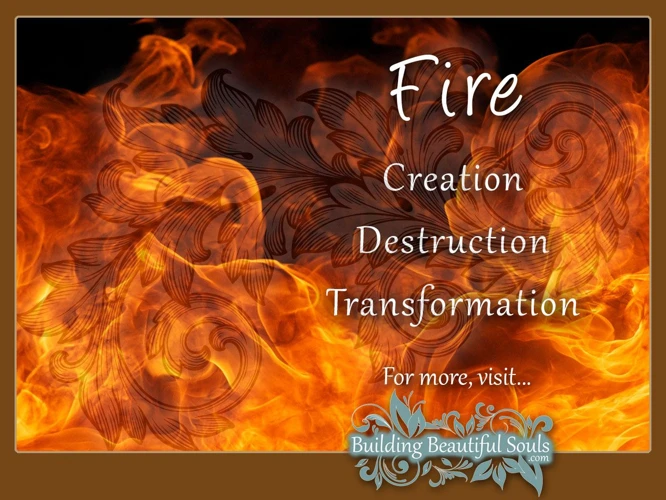
1. Red: The color red is closely linked to Fire and represents passion, strength, and willpower. It embodies the intensity and excitement of the flames. In tarot card readings, red-colored cards often indicate action, courage, and determination. For example, the Two of Wands or the Knight of Wands may signify a call to take bold steps and pursue one’s goals fearlessly.
2. Orange: Orange is another color associated with the Fire element. It combines the energy of red and the warmth of yellow. Orange represents enthusiasm, creativity, and confidence. In tarot readings, orange-colored cards like the Three of Wands or the Ace of Wands may suggest a burst of creative inspiration, new opportunities, and the need to take initiative.
3. Yellow: While yellow is traditionally associated with the Air element, it can also be seen as an extension of the Fire element. Yellow represents the intellectual aspects of Fire, such as communication, clarity, and mental stimulation. In tarot card readings, yellow-colored cards such as the Eight of Wands or the King of Wands may symbolize inspiration, ambition, and the power of assertive communication.
The Fire element ignites a passionate and dynamic energy within tarot cards. It encourages us to embrace our desires, tap into our inner strength, and take bold action to manifest our goals. By understanding the elemental associations of Fire and its corresponding colors, we deepen our understanding of the symbolism present in the tarot deck. This knowledge enhances our tarot readings and allows us to provide more insightful interpretations. Embracing the fire within can truly transform our understanding of the cards and the messages they convey.
The Color Spectrum within the Fire Element
1. Red: The primary color within the Fire element, red represents intense passion, energy, and power. It signifies action, motivation, and courage. Red-colored tarot cards often symbolize the pursuit of goals, ambition, and assertiveness. Examples include the Knight of Wands or the Ace of Wands.
2. Orange: This color embodies enthusiasm, creativity, and vitality. Within the Fire element, orange represents the spark of inspiration and the zest for life. Orange-colored tarot cards may indicate a burst of creativity, new beginnings, and a sense of adventure. Examples include the Page of Wands or the Three of Wands.
3. Gold: This shimmering color symbolizes abundance, success, and achievement. It represents the rewards that come from taking action and pursuing one’s passions. Gold-colored tarot cards often signify material wealth, personal growth, and recognition for one’s efforts. Examples include the Sun card or the Ten of Wands.
4. Maroon: As a deeper shade of red, maroon represents passion in a more focused and intense manner. It signifies determination, resilience, and a strong will. Maroon-colored tarot cards may suggest overcoming challenges, unwavering commitment, and the need for inner strength. Examples include the Nine of Cups or the King of Wands.
Understanding the color spectrum within the Fire element allows tarot readers to interpret the energy and themes associated with these colors in a reading. The fiery colors bring forth a sense of motivation, courage, and creative expression. By recognizing and analyzing these colors, we can harness the power of the Fire element to enhance our tarot readings and gain deeper insights into the messages of the cards. [Learn more about the importance of elementals in tarot readings].
Interpreting Fire-Colored Tarot Cards
1. Passion and Energy: Fire-colored cards, such as the Ace of Wands or the Queen of Wands, often represent a surge of creative energy, ambition, and enthusiasm. These cards may indicate the need to tap into your passions, take bold action, or pursue your goals with vigor.
2. Transformation and Renewal: Fire is associated with change and transformation. Fire-colored cards like the Tower or the Death card suggest that significant changes or shifts are on the horizon. While these changes may be initially disruptive, they can ultimately lead to transformation and growth.
3. Courage and Confidence: Fire represents courage and confidence, and fire-colored cards can signify a need for you to stand firm in your convictions. Cards like the Knight of Wands or the Strength card may indicate that you have the inner strength and determination to overcome challenges and assert yourself.
4. Creativity and Inspiration: Fire is closely linked to creativity and inspiration. Fire-colored cards may signify a burst of creative energy or a need to embrace your artistic side. Cards like the Page of Wands or the Ten of Wands can indicate the exploration of new ideas and the pursuit of creative endeavors.
Remember, interpreting fire-colored tarot cards is not limited to these aspects alone. The specific context of a reading and the surrounding cards should also be considered for a comprehensive interpretation. By paying attention to the elemental associations and the unique symbolism within each tarot card, we can enhance our understanding of the messages they hold and gain deeper insights into our own journey. Read more
Water Element and Color Symbolism
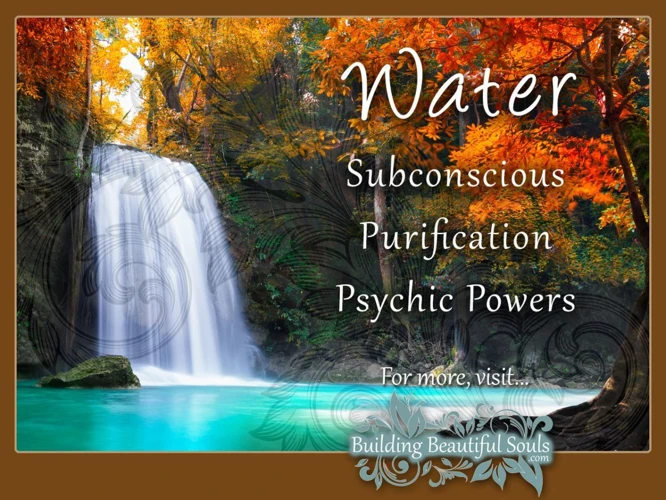
1. Blue: The most prevalent color associated with the Water element, blue represents tranquility, intuition, and emotional depth. It reflects the calmness of still waters and the vastness of the ocean. Blue-colored tarot cards evoke a sense of serenity and may indicate the need to tap into one’s intuition and explore the emotional aspects of a situation.
2. Green: Green is also linked to the Water element, representing growth, healing, and renewal. It reflects the lushness of underwater vegetation and the nourishing energy of water. Green-colored tarot cards may signify the need for emotional healing and growth, as well as the potential for bringing harmony and balance into one’s life.
3. Indigo: Indigo is a deep, mysterious color often associated with spirituality and the depths of the subconscious. It represents the profound wisdom and psychic insights that can be gained through introspection and meditation. Indigo-colored tarot cards may indicate the need for inner reflection and the exploration of one’s spiritual path.
4. Black: While black is technically the absence of color, it holds significant symbolism in tarot readings. It represents the depth of the subconscious mind, the unknown, and the mysteries of life. Black-colored tarot cards may suggest a need to confront and embrace the shadow aspects of oneself or the situation at hand.
By understanding the color symbolism within the Water element, we can gain a deeper understanding of the emotional and intuitive aspects present in tarot readings. These colors serve as gateways to our inner world, offering profound insights and guidance in navigating our emotions and subconscious realms. When interpreting Water-colored tarot cards, it is important to pay attention to the specific shades and tones of these colors, as they can provide additional nuances and meanings to the reading.
The Color Spectrum within the Water Element
1. Blue: Blue is the most commonly associated color with the Water element. It represents emotions, intuition, and spiritual depth. Light blue shades symbolize peacefulness and clarity, while darker blues may signify depth and introspection. Cards with shades of blue, such as the Queen of Cups or the Eight of Cups, often indicate the exploration of emotions and the need for spiritual connection.
2. Teal: Teal is a unique blend of blue and green, combining the energies of both elements. It represents balance, healing, and emotional stability. Teal-colored cards, such as the Temperance card or the Six of Swords, may suggest finding harmony and moderation in life’s challenges.
3. Indigo: Indigo is a deep, mysterious shade of blue that symbolizes wisdom, spiritual insight, and psychic abilities. It represents the profound depths of the subconscious mind. Tarot cards like the Moon or the High Priestess, which feature indigo hues, often indicate a need for trust in one’s intuition and exploration of the unknown.
4. Purple: Although purple is not exclusively associated with the Water element, it holds a connection to intuition and spiritual growth. It represents a blending of energies from both the Water and the Air elements, reflecting wisdom, intuition, and creativity. Purple-colored cards, such as the Hierophant or the Nine of Cups, may suggest a spiritual journey or the pursuit of higher knowledge.
By understanding the various colors within the Water element, we can gain a deeper understanding of the emotional and intuitive aspects of a tarot reading. Paying attention to the colors present in water-themed cards allows us to tap into the energies of the element and interpret the messages more accurately. Remember to consider the specific shades and tones of the colors, as they can provide additional insights into the reading.
Interpreting Water-Colored Tarot Cards
1. Light Blue: This shade represents serenity, peace, and tranquility. Cards like the Star or the Six of Cups, which feature light blue hues, suggest a sense of calmness and emotional healing. They may indicate a need for introspection and connecting with one’s inner voice.
2. Deep Blue: Symbolizing depth, mystery, and the unknown, deep blue-colored cards evoke a sense of intuition and heightened spiritual awareness. The Moon or the Knight of Cups, with their deep blue tones, may indicate the need to trust one’s instincts and tap into hidden emotions or intuitive guidance.
3. Turquoise: Combining elements of blue and green, turquoise represents emotional balance, healing, and communication. Cards like the Page of Cups or the Ace of Cups, featuring turquoise tones, may signify new emotional beginnings, creative expression, and open-heartedness.
4. Aqua: This shade of blue-green is associated with clarity, purification, and adaptability. Cards such as Temperance or the Two of Cups, with aqua-colored elements, suggest the need for balance, harmony, and flexibility in relationships and emotional situations.
5. Navy Blue: Representing deep emotions, authority, and wisdom, navy blue-colored cards carry a sense of depth and understanding. The High Priestess or the King of Cups, with their navy blue hues, may symbolize the need for emotional maturity, introspection, and embracing one’s intuitive abilities.
Interpreting water-colored tarot cards involves delving into the realm of emotions, intuition, and the subconscious. By considering the specific shades of blue and their associated symbolism, we can gain a deeper understanding of the messages these cards hold. Remember, intuitive insights and emotional connections are key when interpreting water-colored tarot cards.
Air Element and Color Symbolism
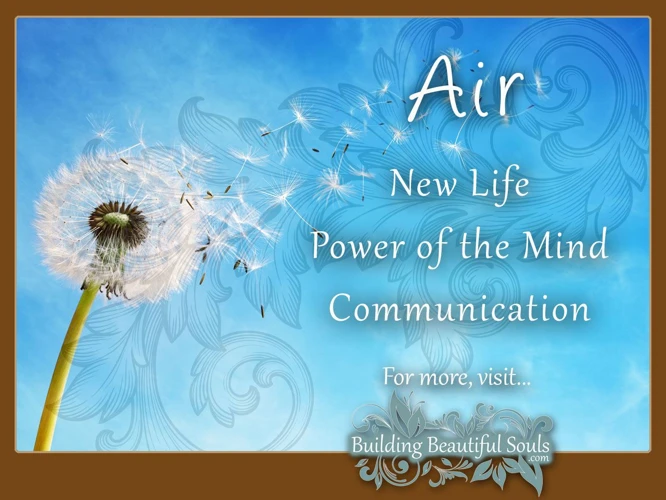
1. Yellow: Yellow is the primary color associated with the Air element. It represents intelligence, optimism, and clarity of thought. It stimulates mental activity and encourages logical thinking and effective communication. Yellow-colored tarot cards like the Page of Swords or the Three of Swords often indicate intellectual growth and the need for clear and concise communication.
2. Light Blue: Light blue is another color closely linked to the Air element. It symbolizes tranquility, serenity, and open-mindedness. Light blue-colored tarot cards such as the Knight of Swords or the Eight of Swords may suggest a need for mental clarity and a willingness to consider new viewpoints.
3. White: White, although not a color in the traditional sense, is often associated with the Air element due to its symbolic representation of purity, clarity, and spirituality. White-colored tarot cards like The Fool or The World may indicate new beginnings, fresh perspectives, and a higher level of consciousness.
When interpreting tarot cards associated with the Air element, it is essential to consider the significance of these colors. The presence of yellow, light blue, or white in a reading may highlight the importance of clear communication, intellectual pursuits, and the exploration of new ideas. By understanding the symbolism of colors within the Air element, we can gain deeper insights into the messages of the cards and enhance our tarot reading abilities.
The Color Spectrum within the Air Element
1. Yellow: Yellow is a vibrant and lively color that represents intellect, clarity, and logical thinking. In the context of the Air element, yellow symbolizes mental agility and the power of the mind. Tarot cards with prominent yellow hues, such as the Page of Swords or the Three of Swords, may suggest intellectual growth, effective communication, and the need for clear thinking.
2. Light Blue: Light blue is a calming and soothing color that evokes a sense of tranquility and serenity. It represents clear communication, intuition, and spirituality. In the Air element, light blue symbolizes the connection between the conscious and subconscious mind. Tarot cards featuring light blue tones, such as the Knight of Swords or the Six of Swords, may indicate the need to trust your intuition, seek spiritual guidance, and find peace in your thoughts.
3. White: White is a symbol of purity, clarity, and a blank slate ready to be filled with ideas and thoughts. It represents the unbounded potential of the mind and the openness to new possibilities. In the context of the Air element, white symbolizes the power of objectivity and unbiased thinking. Tarot cards with white backgrounds, such as The Fool or The World, may suggest the need to approach situations with an open mind, embrace new perspectives, and let go of preconceived notions.
4. Silver: Silver is a reflective and illuminating color that represents adaptability, flexibility, and the ability to see things from multiple angles. It symbolizes the exchange of ideas and the power of persuasion. In the Air element, silver signifies the synergy between different perspectives and the art of negotiation. Tarot cards featuring silver accents, such as the Queen of Swords or the Ace of Swords, may suggest the need to find common ground, listen to others’ viewpoints, and engage in constructive dialogues.
Understanding the color spectrum within the Air element provides insight into the intellectual and communicative aspects of tarot card interpretations. By recognizing these colors and their associated qualities, we can deepen our understanding of the messages conveyed by the cards and provide more nuanced readings.
Interpreting Air-Colored Tarot Cards
1. The Suit of Swords: In the Rider-Waite tarot deck, the suit of Swords is often associated with the Air element. These cards represent the realm of the mind, rationality, and mental challenges. The Ace of Swords, for example, signifies new ideas or a breakthrough in thinking. The Queen of Swords embodies intellect, sharpness, and the ability to communicate with precision. When these Air-colored cards appear in a reading, they may indicate the need for clear and objective thinking or the presence of intellectual conflicts.
2. Yellow or White Colors: In tarot, yellow or white often represent the Air element. These colors symbolize mental agility, logic, and quick thinking. When we see yellow or white in a card, such as the yellow tunic of the Fool or the white clouds in the background of the Temperance card, it suggests the importance of mental processes and analytical thought. It may also imply the need to communicate effectively or seek intellectual pursuits.
3. Open Spaces or Heights: Another indicator of Air energy in tarot cards is the presence of open spaces or heights. This can be seen in cards like the Star or the Eight of Swords, where the vast sky or elevated positions play a significant role. These images reflect the expansive nature of the Air element, emphasizing the ability to rise above challenges, gain a broader perspective, and embrace freedom of thought.
4. Symbolic Elements: Air-related symbols can further enhance the interpretation of tarot cards. Feathers, birds, wind, or clouds are often depicted in Air-colored cards. These symbols represent the qualities of Air, including freedom, adaptability, and fluidity of thought. The presence of these elements invites us to embrace intellect, innovation, and effective communication in our interpretation of the cards.
By understanding the symbolism embedded in Air-colored tarot cards, we can tap into the realm of thought, intellect, and communication. These cards evoke the need for mental clarity, objective analysis, and the power of effective dialogue. Remember to consider both the individual card meanings and the overall context of the reading to gain a comprehensive understanding of the messages conveyed by Air-colored tarot cards.
Earth Element and Color Symbolism
The Color Spectrum within the Earth Element:
1. Green: Green is the most prominent color within the Earth element. It symbolizes nature, growth, and abundance. Green-colored tarot cards often indicate fertility, prosperity, and a strong connection to the natural world. The Empress card, for example, is typically depicted in shades of green and represents nurturing, creativity, and the fertility of the earth.
2. Brown: Brown is another color closely associated with the Earth element. It represents stability, grounding, and practicality. Brown-colored tarot cards often suggest a need for stability and a focus on practical matters. The Four of Pentacles, for instance, is often depicted in shades of brown, emphasizing the importance of financial security and stability.
3. Beige: Beige is a neutral color often associated with the Earth element. It represents simplicity, neutrality, and a connection to the physical world. Beige-colored tarot cards may signify a need for balance and harmonious integration of the physical and spiritual realms.
Interpreting Earth-Colored Tarot Cards:
When interpreting Earth-colored tarot cards, it is essential to consider the significance of the Earth element and its associated colors. These colors often indicate aspects related to the physical world, such as finances, health, and material possessions. They may also suggest a need for stability, groundedness, and finding balance in one’s life. Paying attention to the specific shades and hues of the Earth-colored cards can provide additional insights and nuances to their interpretation.
The Earth element and its corresponding colors hold valuable symbolism in tarot card readings. Understanding the meanings behind the different Earth-colored tarot cards can deepen our understanding of the material aspects of our lives and guide us towards a more grounded and balanced existence.
The Color Spectrum within the Earth Element
1. Brown: Symbolizes stability, reliability, and practicality. Brown is often associated with the earth itself, representing the solid foundation and grounding energy. Cards with brown hues, such as the Knight of Pentacles or the Ten of Pentacles, may indicate a focus on material stability and long-term security.
2. Green: Represents growth, abundance, and fertility. Green is closely associated with nature and the natural world, offering a sense of harmony and balance. Tarot cards with shades of green, like the Empress or the Six of Pentacles, may suggest opportunities for growth, healing, and prosperity.
3. Gray: Symbolizes wisdom, neutrality, and neutrality. Gray is a neutral color that bridges the gap between black and white. It offers a sense of practicality and objectivity. Tarot cards with gray tones, such as the Hermit or the Four of Swords, may indicate the need for introspection, solitude, and inner reflection.
4. Earthy Tones: In addition to specific colors, the Earth element can encompass a range of earthy tones, including sandy beige, warm tan, and deep maroon. These colors represent the natural world, stability, and a connection to the physical realm. Tarot cards with earthy tones, like the Ace of Pentacles or the World card, may signify a focus on practical matters, tangible outcomes, and a sense of completion.
By understanding the color spectrum within the Earth element, we can deepen our interpretation of tarot cards that correspond to this element. The colors within this spectrum provide valuable insights into themes of stability, growth, wisdom, and connection to the physical world. Incorporating these color associations into our tarot readings allows us to unlock a deeper understanding of the messages waiting to be revealed.
Interpreting Earth-Colored Tarot Cards
1. Brown: The color brown is often associated with the Earth element and represents grounding, stability, and practicality. Brown-colored cards such as the Knight of Pentacles or the Four of Pentacles may suggest a focus on financial matters, stability, and the practical aspect of life.
2. Green: Green is another color closely associated with the Earth element. It symbolizes growth, abundance, and harmony with nature. Green-colored cards like the Empress or the Ten of Pentacles may indicate prosperity, fertility, and a connection to the natural world.
3. Beige/Tan: Beige or tan colors often symbolize neutrality, blending, and adaptability. These colors can be found in cards such as the Two of Pentacles or the Six of Pentacles, which may suggest the need to find balance, adapt to changing circumstances, and make practical choices.
4. Black: While black is not typically associated with the Earth element, it can still appear in Earth-colored tarot cards, such as the Eight of Pentacles. In this context, black may represent the mysteries of the material world, hidden potential, or the need for introspection and self-reflection.
When interpreting Earth-colored tarot cards, it is essential to consider the context of the reading and the surrounding cards. These cards often indicate practical matters, financial stability, and a grounded approach to life. They may suggest the need to focus on material concerns, establish a sense of security, or cultivate a connection with the natural world. By paying attention to the colors and their associated meanings, we can gain deeper insights into the messages within Earth-colored tarot cards.
Conclusion
Frequently Asked Questions
1. Why is color symbolism important in tarot card readings?
Color symbolism adds depth and nuance to tarot card readings by conveying various emotions, energies, and themes. It helps readers tap into their intuition and interpret the cards’ messages more effectively.
2. How do elemental associations enhance tarot readings?
Elemental associations provide a framework for understanding the different energies and qualities represented by the four elements (Fire, Water, Air, and Earth) in tarot card readings. They enhance interpretations and offer a broader perspective on the cards’ meanings.
3. Can the same color have different meanings in different tarot decks?
Yes, the interpretation of colors in tarot decks can vary. While there are generally accepted meanings for colors, different deck creators may infuse their own symbolism and interpretations into the colors used in their decks.
4. What if a tarot card has multiple colors?
When a tarot card incorporates multiple colors, it is essential to consider the symbolism of each color individually as well as the combination of colors. This holistic approach provides a more comprehensive interpretation of the card.
5. Are there specific color combinations that hold significance in tarot card readings?
Yes, certain color combinations can hold additional meanings in tarot card readings. For example, a combination of red and blue may symbolize the blending of passion and intuition, suggesting a harmony between action and emotion.
6. How can I incorporate color symbolism into my own tarot readings?
To incorporate color symbolism into your tarot readings, start by familiarizing yourself with the traditional meanings associated with different colors. Pay attention to the colors present in the cards, and consider how they interact with the card’s overall message and the querent’s question.
7. Can the absence of color in a tarot card hold significance?
Yes, the absence of color or the use of grayscale in a tarot card can convey its own message. It may represent a lack of clarity, neutrality, or a need to explore deeper emotions or concepts beyond the surface level of understanding.
8. How can I deepen my understanding of color symbolism in tarot cards?
To deepen your understanding of color symbolism, explore various sources such as books, online resources, and courses that delve into the subject. Practice observing and reflecting on the colors in tarot cards during readings to strengthen your intuition.
9. Are there cultural differences in interpreting color symbolism in tarot cards?
Yes, color symbolism can vary across cultures. Some colors may have different meanings and associations in different cultural contexts, so it is essential to consider cultural perspectives when interpreting tarot card colors.
10. Can I use my intuition to interpret color symbolism in tarot cards?
Yes, intuition plays a vital role in interpreting color symbolism in tarot cards. Trust your instincts and personal connection with the cards to uncover the meanings and messages that resonate with you and the querent.
